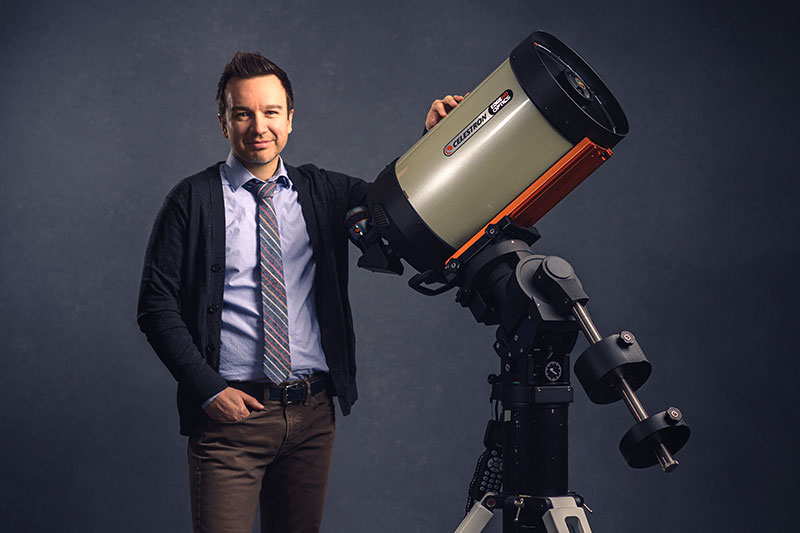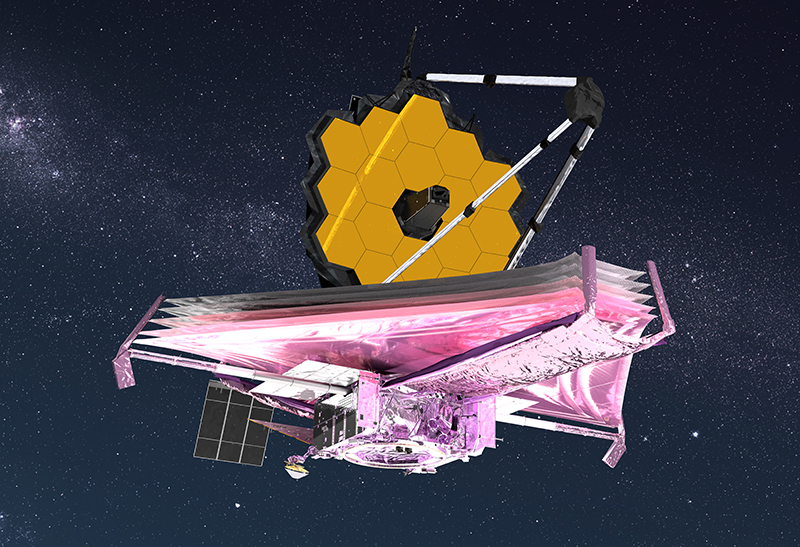
Danny Milisavljevic, assistant professor of physics and astronomy in Purdue University's College of Science, is leading a research team using the world's most powerful telescope, launching later this month. (Purdue University photo/Rebecca McElhoe)
WEST LAFAYETTE, Ind. — The sight of the stars the first time he peered into a telescope floored Danny Milisavljevic. There, right before his eyes, was an entire universe full of planets and details, unexplored and unexpected.
Now, as an assistant professor of physics and astronomy in Purdue University's College of Science, Milisavljevic (pronounced milli-sahv-la-vich) is helping bring details from the world's newest and most powerful telescope: the James Webb Space Telescope (JWST), the successor to the Hubble Space Telescope, which allowed humans to see farther into space and deeper into time.
Since its launch in 1990, discoveries from Hubble have changed humanity's understanding of the stars, of its place in them and of physics itself. JWST is scheduled to launch at the earliest on Dec. 24. Updates on the launch information online. Milisavljevic and many of his collaborators will watch the launch and provide live commentary on the science and plans for the JWST's future. Observers from around the world can attend virtually.
The JWST is bigger, is more complex and will orbit farther from the Earth than Hubble, allowing it unprecedented opportunities for interstellar sleuthing. JWST will look even farther into space and time, and with an unprecedented range of wavelengths and strength of definition. The knowledge it uncovers may help scientists take the next small steps out into the universe — and discern where humans want to go next and why.
Milisavljevic leads a team of nearly 40 scientists and researchers from more than 30 institutions — including Harvard, Princeton and Johns Hopkins universities, as well as Los Alamos National Laboratory and the SETI Institute — in studying Cassiopeia A, one of the more puzzling objects in the galaxy. Cassiopeia A comprises the remnants of a supernova explosion and has at its heart a neutron star that doesn't behave the way scientists think neutron stars ought to behave.
"JWST is going to allow us to look at stellar objects at wavelengths and resolutions we've never been able to use before," Milisavljevic said. "Supernova remnants are leftover explosions — that's what we'll be studying. We'll be able to study what type of star was there before the explosion, the physics of the explosion, the type of dust it generated and what made it all happen. Supernova explosions make all the materials for life — the oxygen we breathe, the iron in our blood."
Bigger, farther, better
 An artist's rendering of the James Webb Space Telescope, the Hubble's successor. It will orbit Earth four times farther out than the moon and employ an unprecedented range of wavelengths and strength of definition (NASA GSFC/CIL illustration/Adriana Manrique Gutierrez)
An artist's rendering of the James Webb Space Telescope, the Hubble's successor. It will orbit Earth four times farther out than the moon and employ an unprecedented range of wavelengths and strength of definition (NASA GSFC/CIL illustration/Adriana Manrique Gutierrez) JWST is larger than Hubble. Its primary mirror is about 20 feet across, while Hubble's is just 8 feet across. Hubble's telescopes looked primarily at objects in the ultraviolet, visual and near-infrared wavelengths. But many objects that astronomers want to see and study — like the universe's oldest galaxies, exoplanets and stars — are hidden behind swaths of dust. Infrared wavelengths allow scientists to get a clearer view than visual wavelengths of light could give them.
Hubble rode into space aboard the shuttle Discovery. Hubble's orbit is about 350 miles up. JWST will orbit Earth from nearly a million miles away — four times farther away than the moon and 2,500 times farther out than Hubble.
JWST's destination is a special spot in space called L2, or the second Lagrange Point. It's a place where, thanks to the orbital dynamics of Earth, the moon and sun, it will stay in a fixed position with respect to Earth — always keeping Earth between itself and the sun. This is an ideal location from which to observe the universe because the satellite won't have to use too much of its fuel in adjustments to its orbit, a vital consideration since it will be so far away from its home planet.






